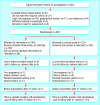Randomised controlled trial of pelvic floor muscle training during pregnancy
- PMID: 15253920
- PMCID: PMC509343
- DOI: 10.1136/bmj.38163.724306.3A
Randomised controlled trial of pelvic floor muscle training during pregnancy
Abstract
Objectives: To examine a possible effect on labour of training the muscles of the pelvic floor during pregnancy.
Design: Randomised controlled trial.
Setting: Trondheim University Hospital and three outpatient physiotherapy clinics in a primary care setting.
Participants: 301 healthy nulliparous women randomly allocated to a training group (148) or a control group (153).
Intervention: A structured training programme with exercises for the pelvic floor muscles between the 20th and 36th week of pregnancy.
Main outcome measures: Duration of the second stage of labour and number of deliveries lasting longer than 60 minutes of active pushing among women with spontaneous start of labour after 37 weeks of pregnancy with a singleton fetus in cephalic position.
Results: Women randomised to pelvic floor muscle training had a lower rate of prolonged second stage labour (24%, 95% confidence interval 16% to 33%; 22 out of 105 women were at risk (undelivered) at 60 minutes in the survival analysis) than women allocated to no training (38% (37/109), 28% to 47%). The duration of the second stage was not significantly shorter (40 minutes v 45 minutes, P = 0. 06).
Conclusions: A structured training programme for the pelvic floor muscles is associated with fewer cases of active pushing in the second stage of labour lasting longer than 60 minutes.
Figures


Comment in
-
Pelvic floor muscle training during pregnancy facilitates labour.Aust J Physiother. 2004;50(4):258. doi: 10.1016/s0004-9514(14)60119-7. Aust J Physiother. 2004. PMID: 15643712 No abstract available.
References
-
- Reilly ETC, Freeman RM, Waterfield MR, Waterfield AE, Steggles P, Pedlar F. Prevention of postpartum stress incontinence in primigravidae with increased bladder neck mobility: a randomised controlled trial of antenatal pelvic floor exercises. Br J Obstet Gynaecol 2002;109: 68-76. - PubMed
-
- Mørkved S, Bø K, Schei B, Salvesen KÅ. Pelvic floor muscle training during pregnancy to prevent urinary incontinence: A single-blind randomized controlled trial. Obstet Gynecol 2003;101: 313-9. - PubMed
-
- UK Midwifery Archives. Hannah, midwife. Does horse-riding affect the pelvic floor? www.radmid.demon.co.uk/pelvicfloor.htm (accessed 25 Jun 2004).
-
- Baby Centre. How do pelvic floor exercises help me? www.babycentre.co.uk/refcap/536339 (accessed 25 Jun 2004).
-
- Nielsen CA, Sigsgaard I, Olsen M, Tolstrup M, Danneskiold-Samsoee B, Bock JE. Trainability of the pelvic floor. A prospective study during pregnancy and after delivery. Acta Obstet Gynecol Scand 1988;67: 437-40. - PubMed
